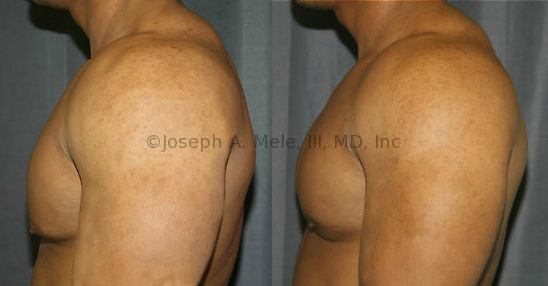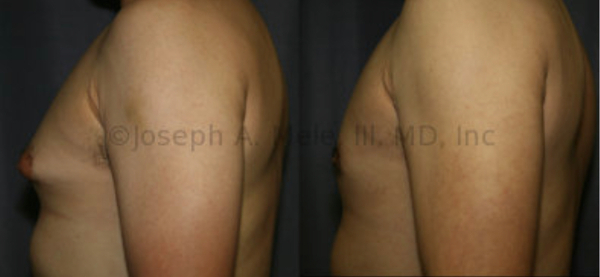Gynecomastia is an enlargement of male breast tissue. It can present as a palpable mass beneath the nipple, puffy nipples or enlargement of the entire male breast.
Gynecomastia at Birth
Gynecomastia is something every male is born with. The mother’s hormones cross the placental barrier and cause enlargement of the newborn’s breast tissue. After birth, the levels of these hormones drop quickly, causing the gynecomastia to resolve.
Gynecomastia at Puberty
Gynecomastia frequently occurs at puberty. In many cases, the overdevelopment of the breast tissue resolves in a year or two. Often, however, it persists. When a significant amount of breast tissue develops, the fullness can be noticeable.
Gynecomastia and Steroid Use
Gynecomastia can develop in response to exogenous hormones too. Anabolic steroids can lead to growth of breast tissue in men. Anabolic steroids are androgenic, however, an enzyme (aromatase), converts testosterone to estradiol. Side effects include testicular atrophy, infertility and gynecomastia.
Gynecomastia usually presents as a firm, rubbery mass directly behind the nipple and areola. Once it forms, it stays, and does not resolve even after stopping steroids. Aromatase inhibitors, like those used for the prevention of breast cancer recurrence, are not effective for reducing the gynecomastia after it has formed.
Gynecomastia and Medications
The most common reason for adult onset gynecomastia is prescription drug use. Many common medications used to treat high blood pressure and heart disease have gynecomastia formation as a side effect. The hormones used to treat prostate cancer also can cause significant breast tissue development. Marijuana is also common causal agent.
Gynecomastia and Cancer
Gynecomastia, by definition, is a benign enlargement of the male breast tissue. Breast lumps in men are rarely cancerous. Gynecomastia is firm but rubbery and is mobile within the breast. The possibility of a breast cancer is increased for hard, fixed masses, especially if they continue to enlarge. Testicular cancer can also present as gynecomastia.
Male Breast Reduction and Gynecomastia Reduction
Once overdeveloped, male breast tissue does not usually spontaneously shrink. Often, the enlargement is enough to be noticed even through clothing. Many men with gynecomastia are uncomfortable wearing t-shirts, and will dress in layers to hide their embarrassment. Plastic surgeons can discretely remove the offending tissue and restore a more masculine chest.
Gynecomastia – Male Breast Reduction – Before and After Pictures
Gynecomastia Surgery
The primary methods for removing gynecomastia are Liposuction and direct excision of the glandular tissue. Soft tissue can be removed via small liposuction incisions, while firmer tissue requires an incision placed around the lower areola for direct removal. In rare cases when the skin itself has been stretched out of shape, removal of skin maybe required, and an incision may be placed in the fold under the breasts.
Schedule Your Gynecomastia Consultation
The best way to review your options for Gynecomastia Reduction is during a consultation with a Board Certified Plastic Surgeon. After a brief history and examination, I can discuss the treatment(s) most likely to achieve the best results. Male Breast Reduction is an outpatient procedure, so no hospitalization is required. You can go home the same day, and resume most activities in a few days to a week. Vigorous workouts and contact sports require a few weeks of rest. More information about gynecomastia treatment is available here: Gynecomastia Information.
Call our San Francisco Bay Area Plastic Surgery office in Walnut Creek, California, to schedule your Gynecomastia consultation today at (925) 943-6353, or ask your gynecomastia reduction questions via the contact form to the left.
Previous Post Next Post
